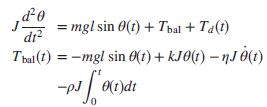Humans are able to stand on two legs through a complex feedback system that includes several sensory
Question:
Humans are able to stand on two legs through a complex feedback system that includes several sensory inputs— equilibrium and visual along with muscle actuation. In order to gain a better understanding of the workings of the postural feedback mechanism, an individual is asked to stand on a platform to which sensors are attached at the base. Vibration actuators are attached with straps to the individual’s calves. As the vibration actuators are stimulated, the individual sways and movements are recorded. It was hypothesized that the human postural dynamics are analogous to those of a cart with a balancing standing pole attached (inverted pendulum). In that case, the dynamics can be described by the following two equations:

where m is the individual’s mass; l is the height of the individual’s center of gravity; g is the gravitational constant; J is the individual’s equivalent moment of inertia; η; ρ, and k are constants given by the body’s postural control system; θ(t) is the individual’s angle with respect to a vertical line; Tbal(t) is the torque generated by the body muscles to maintain balance; and Td(t) is the external torque input disturbance. Find the transfer function Θ(s)/Td(s) (Johansson, 1988).
Step by Step Answer:






